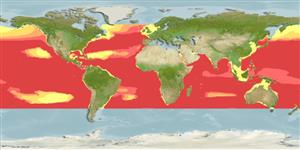Environment: milieu / climate zone / depth range / distribution range
Ökologie
seewasser bathypelagisch; tiefenbereich 16 - 4663 m (Ref. 58302), usually 600 - 1800 m (Ref. 58302). Deep-water; 61°N - 40°S, 180°W - 180°E
Atlantic, Indian and Pacific: in tropical to temperate waters. Southern Ocean: Indian Ocean sector south of Australia. South China Sea (Ref.74511).
Length at first maturity / Size / Gewicht / Alter
Maturity: Lm 4.3 range ? - ? cm
Max length : 4.8 cm SL Männchen/unbestimmt; (Ref. 5162); 7.5 cm SL (female)
Rückenflossenstacheln (insgesamt): 0; Rückenflossenweichstrahlen (insgesamt): 12-15; Afterflossenstacheln 0; Afterflossenweichstrahlen: 16 - 19. Light to dark brown in color; transparent or slightly pigmented immediately anterior to anal and dorsal origin; median fin rays and internasal area pigmented; meningeal pigment extending to level of rear margin of eye (Ref. 3991).
Meso- to bathypelagic (Ref. 58302). Oceanic, precise depth range dependent upon developmental stage, latitude, season (Ref. 4769). Does not exhibit diel vertical migrations (Ref. 4769). Lipid content is 2.3 % in fresh body weight and wax ester is 34.0 % in total lipids (Ref. 9193).
Gon, O., 1990. Gonostomatidae. p. 116-122. In O. Gon and P.C. Heemstra (eds.) Fishes of the Southern Ocean. J.L.B. Smith Institute of Ichthyology, Grahamstown, South Africa. 462 p. (Ref. 5162)
IUCN Rote Liste Status (Ref. 130435)
Bedrohung für Menschen
Harmless
Nutzung durch Menschen
Fischereien: nicht kommerziell
Mehr Information
ReferenzenAquakulturAquakultur ProfilZuchtlinienGenetikElectrophoresesVererbbarkeitKrankheitenVerarbeitungNutrientsMass conversion
PartnerBilderStamps, Coins Misc.LauteCiguateraGeschwindigkeitSchwimmstilKiemenoberflächeOtolithsGehirngrößeSehfähigkeit
Tools
Zusatzinformationen
Download XML
Internet Quellen
Estimates based on models
Preferred temperature (Ref.
123201): 2.5 - 8.7, mean 4.2 °C (based on 3651 cells).
Phylogenetic diversity index (Ref.
82804): PD
50 = 0.5001 [Uniqueness, from 0.5 = low to 2.0 = high].
Bayesian length-weight: a=0.00389 (0.00171 - 0.00885), b=2.99 (2.79 - 3.19), in cm total length, based on LWR estimates for this (Sub)family-body shape (Ref.
93245).
Trophic level (Ref.
69278): 3.2 ±0.36 se; based on food items.
Widerstandsfähigkeit (Ref.
120179): mittel, Verdopplung der Population dauert 1,4 - 4,4 Jahre. (tm=3.5).
Fishing Vulnerability (Ref.
59153): Low vulnerability (10 of 100).
